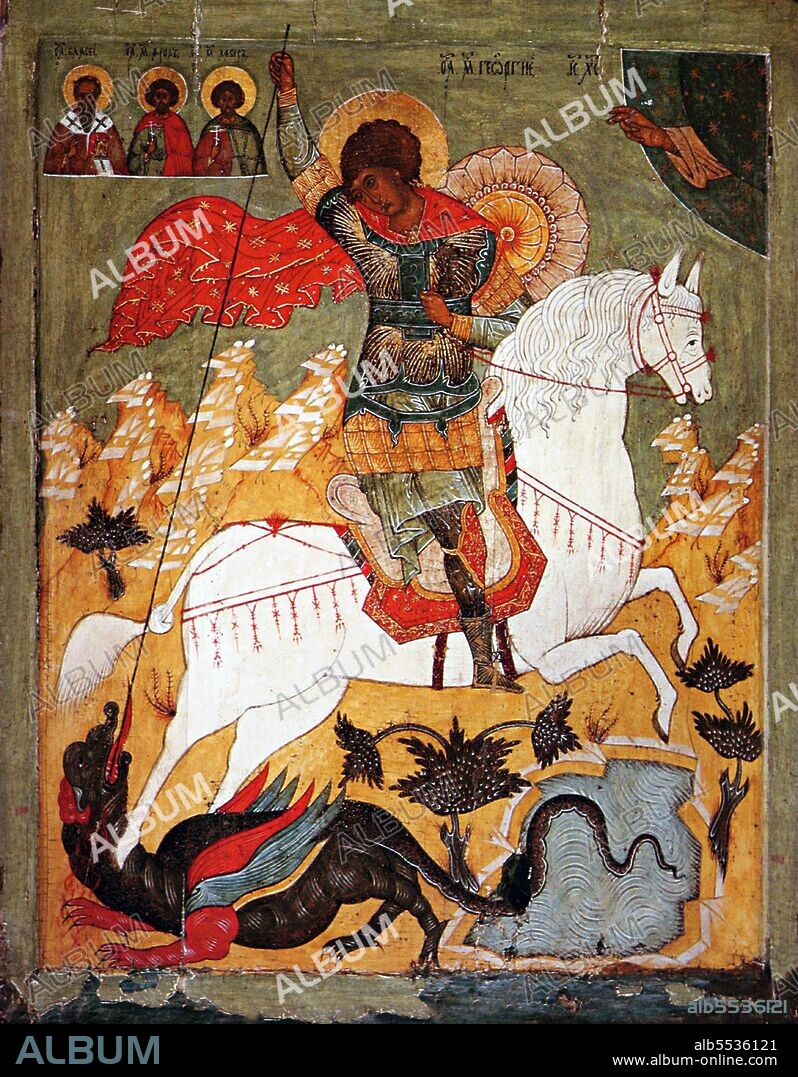alb5536121
Russia: Icon of St George and the Dragon, Pskov,16th century.

|
Add to another lightbox |
|
Add to another lightbox |



Title:
Russia: Icon of St George and the Dragon, Pskov,16th century.
Caption:
The story of Saint George and the Dragon appended to the hagiography of Saint George was Eastern in origin, brought back with the Crusaders and retold with the courtly appurtenances belonging to the genre of Romance. The earliest known depictions of the motif are from tenth- or eleventh-century Cappadocia and eleventh-century Georgia; previously, in the iconography of Eastern Orthodoxy, George had been depicted as a soldier since at least the seventh century. The earliest known surviving narrative of the dragon episode is an eleventh-century Georgian text. The dragon motif was first combined with the already standardised Passio Georgii in Vincent of Beauvais' encyclopedic Speculum Historiale, and then Jacobus de Voragine's Golden Legend (ca 1260) guaranteed its popularity in the later Middle Ages as a literary and pictorial subject. The legend gradually became part of the Christian traditions relating to Saint George and was used in many festivals thereafter.
Credit:
Album / Pictures from History/Universal Images Group
Releases:
Model: No - Property: No
Rights questions?
Rights questions?
Image size:
3700 x 4750 px | 50.3 MB
Print size:
31.3 x 40.2 cm | 12.3 x 15.8 in (300 dpi)
Keywords:
ARMS • ART • ARTS • ASIA IMAGE • ASIA PICTURES • ASIA • ASIAN IMAGE • ASIAN IMAGES • ASIAN PICTURES • ASIAN • CAVALRY • CHEVALIER • CHIVALRY • CHRIST • CHRISTIAN • CHRISTIANISM • CHRISTIANITY • CHRISTIANS • CRISTIANDAD • CRISTIANISMO • CULT • DRAGON • DRAGONS • EQUUS CABALLUS • GENTLEMEN • HISTORICAL IMAGES • HISTORICAL PICTURES • HISTORICAL • HISTORY IMAGES • HISTORY PICTURES • HORSE • HORSEMAN • JESUS CHRIST • JESUS • KNIGHT • KNIGHTS • LEGEND • MYTH • MYTHOLOGY • PAINT • PAINTING • PASSION OF CHRIST • PASSION • RELIGION • RELIGION: CHRISTIAN • RIDER • RITE • RITUAL • RUSIA • RUSSIA • RUSSIAN • SAINT GEORGE • WATER • WEAPON • WEAPONRY • WEAPONS
 Pinterest
Pinterest Twitter
Twitter Facebook
Facebook Copy link
Copy link Email
Email

